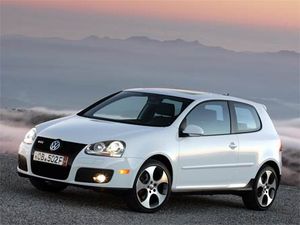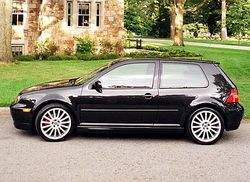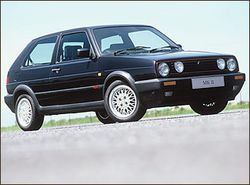.
Volkswagen GTI

| |
| Volkswagen GTI | |
|---|---|
| Volkswagen AG | |
| aka | |
| Production | 1973-Present |
| Class | Compact |
| Body Style | 3- or 5-Door Hatchback |
| Length | 165.8 in. |
| Width | 69.3 in. |
| Height | 58.4 in. |
| Wheelbase | 101.5 in. |
| Weight | 3,100-3,212 lbs. |
| Transmission | 6-speed Manual 6-speed DSG |
| Engine | 2.0 liter Turbocharged inline-4 |
| Power | 200 hp @ 5100-6000 RPM 207 lb-ft @ 1800-5000 RPM |
| Similar | Hyundai Tiburon Honda Civic Si Mazdaspeed3 Scion TC Subaru Impreza |
| Designer | |
The name GTI was first used in 1976, in reference to Volkswagen's high-performance trim level of the Golf (known as the Rabbit when it debuted in North America in 1975). The Volkswagen GTI is widely credited with beginning the first in the hot hatch or European hatchback genre. While a GTI was released for the 2006 model year, Volkswagen redesigned the car in early 2006, calling it the "New GTI."
See Wikicars' comprehensive Volkwagen GTI Review.
Recent Changes
Although the 2006 model remains largely unchanged from its fourth generation platform, the newly redesigned fifth generation "New GTI" features some new and improved updates.
Styles and Major Options
There are two styles available for the Volkswagen GTI, the 3 and 5-door hatchback. These trims come with the following options:
- Alloy wheels
- Power sunroof
- Sport seats
- Alloy pedals
- Racing inspired steering wheel
- Extra grab handles
- Turbocharged, intercooled, direct fuel injected, 200hp, 2.0T engine
- 6 speed manual transmission
- ABS four wheel disc lock brakes
Pricing
Today's actual prices for the 2008 Volkswagen GTI can be found at CarsDirect.
|
GTI Trims |
|
GTI Mk V |
|
MSRP |
|
$21,990 |
|
Invoice |
|
$20,240 |
Gas Mileage
As seen on the FuelEconomy.gov website, the City/Highway MPG averages are as follows:
|
GTI Specs |
|
|
4-Cyl. 2.0L 6-Speed
|
4-Cyl. 2.0L 6-Speed
|
|
MPG |
|
|
25/31 |
24/31 |
Reliability
Safety
The GTI comes with the following standard safety features:
- 4-wheel Anti-lock braking system
- Brake Assist
- Stability Control
- Front, Side, and Curtain airbags
- Occupancy Sensor
Photos
Colors
The Volkswagen GTI comes in the following colors, but GTI colors may vary by trim:
Exterior
- Black Magic
- Candy White
- Reflex Silver
- Silverstone Gray
- Tornado Red
- United Gray
Interior
- Black
- Black/Gray
- Interlagos
Main Competitors
Hybrid Models
There are currently no hybrid models of the GTI.
Unique Attributes
Over the standard Golf on which it is based, the GTI features unique 'Interlagos' chequered cloth, harking back to the days of the Mk. 1 Golf GTI. Also, the grill is different to the Golf's - it is a black honeycomb affair, with a black centre bar for the number plate and a red strip around the top section - again, a retrospective take on the Mk. 1 GTI. Other external treatments include the deeper spoilers and side skirts, along with a rear wing and a chromed exhaust.
The engine itself is unique to the GTI, along with the flat-bottomed steering wheel and the 'Monza' alloy wheels, available in both 18- and 19-inch sizes.
Resale Values
Although resale values for the lates incarnation of the GTI are not yet available, the 2005 GTI, according to Kelley Blue Book, is expected to retain its value exceptionally, as well as or better than any car in its class.
Criticisms
- Fast, but heavy (weighs almost as much as the Volkswagen Passat)
Current Generation
The Golf V GTI is hailed as a return-to-form for the progenitor of the genre. The Golf GTI features a 2.0 litre turbocharged inline 4-cylinder engine with FSI (Fuel Stratified Injection) direct-injection technology, which produces 200 bhp. It is available in both 3-door and 5-door hatchback body shapes, and comes with a choice of either 6-speed manual, or a 6-speed automatic DSG gearbox. The concept GTI was first shown to the public at the Frankfurt Motor Show in 2003. The first production model was initially unveiled at the Mondial de l'Automobile in Paris in September 2004 and went on sale around the world shortly thereafter. At the Los Angeles Auto Show in January 2006 the GTI made its long awaited North American debut in 3-door guise. The new GTI has a considerable increase in price over the previous model, mainly due to the features mentioned above and the fact that the exterior itself had not seen such a dramatic aesthetic change in years. The innovative DSG transmission and the 200bhp engine all helped raise the retail price of the car.
Previous Generations
Generation 4
GTI 337 edition (2002)
The GTI 337 was officially introduced at the New York Auto Show and made it to dealers by late May 2002. The price of the GTI 337 was $22,225 in the U.S. and $32,900 in Canada. Only 1,500 units were produced for the American market with an additional 250 specifically for Canada, and it only came in Reflex Silver.
"The 337 name comes from the code name for the Golf model back in the early 1970s," said Frank Maguire, vice president in charge of sales and marketing at Volkswagen of America, Inc. "The GTI is the sport version of the Golf and since we didn't begin selling the GTI here until 1983, the name 337 seemed like a nice way to recognize the history of this vehicle and make it meaningful to our most enthusiastic drivers. This is a very unique car for the Volkswagen lover."
Starting with a 180 hp 1.8T GTI GLS, the following extra equipment and changes have been made:
18" BBS RC Wheels with 225/40-ZR18 High-Performance Summer Tires; greatly improved sport suspension — 1" lower overall ride height; Votex body kit with front valance, side skirts, rear hatch wing and rear valance with 3" chromed exhaust tip; 315 mm (12.3") diameter vented front and 256 mm (10") rear vented brakes with red powder coated calipers; all-new six-speed MQ350 transmission; Recaro front seats in special "Le Mans" red and black cloth with custom GTI embroidery; brushed aluminum interior trim accents; red stitching on steering wheel, shift boot, handbrake knob and seats; special golf ball shift knob; aluminum pedals with rubber inserts; stainless steel exhaust with mild sound tuning; red trimmed floor mats; special exterior retro GTI badging; Monsoon sound system (U.S. only); and more...
20th Anniversary Edition (2003, North America)
Due to the popularity of a commemorative 25th anniversary edition GTI produced in Europe in 2001 (GTI 337 edition in North America), Volkswagen of America produced 4,200 so-branded '20th Anniversary Edition' GTIs and 4000 were shipped to the United States and 200 to Canada. This event, in 2003 marked the 20th anniversary of the GTI's first introduction to the US, then called the Rabbit. Several special features distinguish this new GTI from the rest of the pack.
On the outside, the 20th came with throwback red-lettered 'GTI' logos on the left front and right rear. The rear was also accompanied by a vintage-look chrome rabbit. Blackened headlights and dark-tinted tail lights added a distinctive look, while Votex front, rear, and side skirts along with a hatch spoiler and special edition 18" OZ Aristo alloy wheels complete the exterior transformation. These models were produced only in three colors: Imola Yellow, Jazz Blue and Black Magic Pearl. Distribution of production was 50% Black magic pearl, 25% Jazz Blue and 25% Imola Yellow.
Inside, a few accents were noticeable. Unlike other models, there were no 'options' available. The only true option was ESP, Volkswagen's stability control feature. All 20ths had a sunroof, black leathered with silver stitching steering wheel, shifter boot and emergency brake handle, and sporty black cloth Recaro bucket seats with silver stitching accents and a red 'GTI' emblem embroidered in the middle of the back rest. Aluminum trim came standard, complete with a numbered nameplate above the center console identifying the exact production number (US production only) of the vehicle and a black headliner. This edition also came with a special golf ball shifter knob. Volkswagen's premier 8-speaker Monsoon(tm) stereo system was also standard.
Mechanically speaking, this was the average GTI 1.8T GLS with a few exceptions. A 6-speed manual MQ350 transmission marked the most notable departure from the norm, and upgraded suspension stiffened up the ride and lowered the car approximately 40 mm (uprated springs and shocks, increased sway bar diameters, and revised bushings in the rear). Upgraded disc brakes front (12.3" vented rotors) and rear (10.3" vented rotors) helped bring things to a stop, while red powder-coated calipers added a bit of flair to the package.
Generation 3
The third-generation Golf was launched in November of 1991, although it did not appear in North America until the spring of 1993; three-door Golfs of this generation were mostly only available in North America in GTI form.
The GTI variants (especially with the straight-four 4 cylinder engine) are considered to be the poorest of the performance Golfs, with significantly increased weight, but with minimal power increases. A "best of breed" VR6 variant exists which was available in a well regarded "Highline" trim; this 2.8 L VR6 engine gave a significant boost in power to 174 PS (128 kW/172 hp) for the Mk.III, a car weighing only about 1285 kg (2836 lb). Compare that to the Mk.II GTI that weighed 285 kg (629 lb) less but had only 139 PS (102 kW/137 hp) and a much smaller engine to tune (1.8 L).
A 16-valve version of the third-generation Golf GTI was introduced in 1993. This model was greeted with a muted sense of disenchantment with the motoring press. The engine was the same enlarged to 2.0 L, with power now reaching 150 PS (110 kW/148 hp). While underpowered compared to the VR6, it was still relatively popular with driving enthusiasts in Europe (North America didn't get the GTI version proper, but had the name applied to the VR6 engine). Once again the Golf Driver version took its place as the official GTI-look-alike but with a more humble single-point injected 1.8 L engine.
In 1996 Volkswagen produced a limited 1000 special-edition 3-door '20th Anniversary' GTI's. These had the usual GTI specification but a came with checkered GTI logo'd Recaro sport seats, red seat belts, half-chrome golf ball gear knob, red stitching on the steering wheel and on the handbrake gatter and silver dialed instruments. The red theme continued externally with a red striping on the bumpers and red brake calipers, the wheels were 16" split rim BBS alloys, visually similar to the 15" that were found on VR6 model. Brush stainless steel rear twin tailpipes on the exhaust and smoked front fog and indicator lamps to match the rear lamps. 3 optional extras were made available; electric sunroof, air conditioning and metallic black paintwork. Insurance was based on the standard GTI which made this version a very desirable model. The edition was sold in only 6 colour schemes and the 1000 number figures that were produced was as follows; 600 8 valve models, 150 16 valve models and 250 TDI models.
Generation 2
The GTI was Motor Trend magazine's Car of the Year for 1985, as well as VWVortex's "Best Golf of all time". The MkII GTI failed to make the same waves as the MkI, and failed to win back the Golf GTI's fanbase which had adopted the Peugeot 205 GTI. In North America, where Peugeot did not sell the 205 in any guise, Volkswagen faced tough competition from the Honda Civic S (later Si).
Generation 1
The GTI version of the Volkswagen Golf, launched in Europe in 1976 and in the US in 1983, virtually created the hot hatch genre overnight, and many other manufacturers since have created special sports models of their regular volume selling small hatchbacks. It was one of the first small cars to adopt fuel injection for its sports version, which raised power output of the 1588 cc engine to 110 PS (81 kW/108 hp). In 2004, Sports Car International announced the GTI Mk I as the 3rd best car of the 1980s. In the United States, the Mk1 Golf GTI was known as the Rabbit GTI. For background to the development of the GTI, read, "The People's Porsche", an undergraduate dissertation.
The Volkswagen Rabbit GTI, the North American version of the high-perfomance Golf GTI, debuted in the 1983 model year and was in production for two seasons. Assembled from parts made in Mexico, Canada, Germany and the U.S. in Volkswagen's Westmoreland, Pennsylvania assembly plant, the Rabbit GTI had the same Mk1 chassis, and the same A1 body type as the Mk1 Golf GTI that had been on sale in Europe since 1976, with a few exceptions. Key distinct features of the Rabbit GTI were its GTI surname, the squared front end styling, blue or red felt and leatherette trim, and its alloy "snowflake" wheels. The squared styling of the front end, particularly the wraparound blinkers, gave it added safety and slight improvement in performance. Under the hood, the engine was a JH 1.8 liter 4-cylinder engine that ran on unleaded petroleum fuel. The JH 1.8l was transversely mounted, and it would peak in stock condition at around 80-85 HP. Claims to gas mileage of near-perfectly tuned Rabbit GTIs range bewteen 25 and 30 miles per gallon.
Design quirks and oddities
Awards
- The Volkswagen GTI has been awarded Automobile Magazine's 2007 Automobile of the Year
See also
External Links
This page uses content from Wikipedia; see Volkswagen Golf, which includes these contributors.










